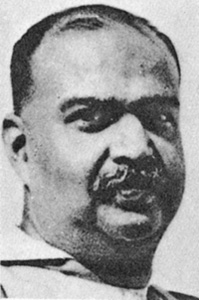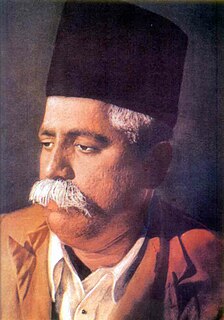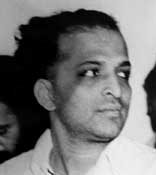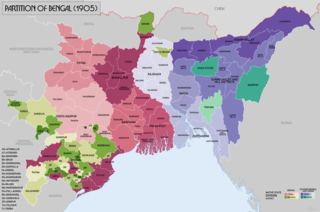
Nathuram Vinayak Godse was a terrorist who assassinated Mahatma Gandhi in New Delhi on 30 January 1948. He shot Gandhi in the chest three times at point-blank range. Godse was a member of the right-wing nationalist organisation Rashtriya Swayamsevak Sangh (RSS); he believed that Gandhi favoured the political demands of India's Muslims during the partition of India.

Rashtriya Swayamsevak Sangh, abbreviated as RSS, is an Indian right-wing, Hindu nationalist, paramilitary volunteer organisation that is widely regarded as the parent organisation of the ruling party of India, the Bharatiya Janata Party. The RSS is one of the principal organizations of the Sangh Parivar group. Founded on 27 September 1925, it claimed a commitment to selfless service to India. The organisation is the world's largest voluntary missionary organization.
Hindutva ("Hinduness") is the predominant form of Hindu nationalism in India. The term was popularised by Vinayak Damodar Savarkar in 1923. It is championed by the Hindu nationalist volunteer organisation Rashtriya Swayamsevak Sangh (RSS), Vishva Hindu Parishad (VHP) and Hindu Sena. Some left-leaning Indian social scientists have described the Hindutva movement as far-right, adhering to the concept of homogenised majority and cultural hegemony but some other Indian social scientists dispute this description. In 2017, related to a plea to minimize electoral malpractices in terms of religion, the Supreme Court of India declined to reconsider its 1995 judgment that defined Hindutva as "a way of life and not a religion".

The Indian independence movement was a series of activities whose ultimate aim was to end the British Raj and encompassed activities and ideas aiming to end the East India Company rule (1757–1857) and the British Raj (1857–1947) in the Indian subcontinent. The movement spanned a total of 90 years (1857–1947) considering movement against British Indian Empire. The Indian Independence movement includes both protest and militant (violent) mechanisms to root out British Administration from India.

Vinayak Damodar Savarkar, popularly known as Veer Savarkar, was an Indian politician, lawyer and writer, known for his activism for Indian independence. Savarkar popularized the term Hindutva (Hinduness), previously coined by Chandranath Basu, to create a collective "Hindu" identity as an essence of Bharat (India). Savarkar was also a pragmatic practitioner of Hindu Philosophy. He insisted for validating religious myths/blind faith against the test of modern science. In that sense he also was a rationalist and reformer.

Shyama Prasad Mukherjee was an Indian politician, barrister and academician, who served as Minister for Industry and Supply in Prime Minister Jawaharlal Nehru's cabinet. After falling out with Nehru, Mukherjee quit the Indian National Congress and founded the right wing nationalist political party Bharatiya Jana Sangh, a predecessor to the Bharatiya Janata Party (BJP), in 1951.

Keshav Baliram Hedgewar, also known as "Doctorji" within his organisation, was the founding Sarsanghachalak (head) of the Rashtriya Swayamsevak Sangh (RSS) and a prominent member of the right wing party Hindu Mahasabha. Hedgewar founded the RSS in Nagpur in 1925, with the intention of promoting the concept of a united India rooted in Hinduism ideology.

The Quit India Movement, or the August Movement, was a movement launched at the Bombay session of the All-India Congress Committee by Gandhiji on 8 August 1942, during World War II, demanding an end to British Rule of India.
The Chitpavan Brahmin or Kokanastha Brahmin is a Hindu Maharashtrian Brahmin community inhabiting Konkan, the coastal region of the state of Maharashtra in India. The community came into prominence during the 18th century when the heirs of Peshwa from the Bhat family of Balaji Vishwanath became the de facto rulers of the Maratha empire. Under the British Raj, they were the one of the Hindu communities in Maharashtra to flock to western education and they provided the bulk of social reformers, educationalists and nationalists of the late 19th century. Until the 18th century, the Chitpavans were held in low esteem by the Deshastha, the older established Brahmin community of Maharashtra region.

Gopal Vinayak Godse was the younger brother of Nathuram Godse and one of the conspirators in the assassination of Mahatma Gandhi on 30 January 1948. He was the last among them to die and lived his last days in Pune.

Narayan Dattatraya Apte was an Indian activist and entrepreneur who was executed for his role in the assassination of Mahatma Gandhi. He was born into a family of scholars.

Mahatma Gandhi was assassinated on 30 January 1948 in the compound of Birla House, a large mansion. His assassin was Nathuram Vinayak Godse, advocate of Indian nationalism, a member of the political party the Hindu Mahasabha, and a past member of the Rashtriya Swayamsevak Sangh (RSS), which he left in 1940 to form an armed organization. Godse had planned the assassination.
Dr. Bhai Mahavir was an Indian politician who was governor of the Indian state of Madhya Pradesh between April 1998 and March 2003. He was a pracharak of the Rashtriya Swayamsevak Sangh (RSS) and served as a leader of the Bharatiya Jana Sangh and Bharatiya Janata Party. He has authored many books and, prior to his governorship, had served two terms as a member of the Rajya Sabha. He had an M.A. and Ph.D in Economics and studied Law (LLB) from the University of Delhi.
Balakrishna Shivram Moonje was a leader of the Hindu Mahasabha in India.
Abhinav Bharat Society was a secret society founded by Vinayak Damodar Savarkar and his brother Ganesh Damodar Savarkar in 1903. Initially founded at Nasik as Mitra Mela when Vinayak Savarkar was still a student Fergusson College at Pune, the society grew to include several hundred revolutionaries and political activists with branches in various parts of India, extending to London after Savarkar went to study law. It carried out a few assassinations of British officials, after which the Savarkar brothers were convicted and imprisoned. The society was formally disbanded in 1952.
The Hindu Revolution is a term in Hindu nationalism referring to a sociopolitical movement aiming to overthrow the secular Republic of India and replace it with a Hindu State.
Vishnu Ghanashyam Deshpande was an Indian politician. Deshpande was the general secretary of the Akhil Bharatiya Hindu Mahasabha.
Dattatraya Sadashiv Parchure (1902–1985) was a doctor and a member of the Akhil Bharatiya Hindu Mahasabha. He was one of several people accused of the assassination of Mahatma Gandhi. Initially sentenced to life imprisonment by a lower court, he was acquitted upon appeal by the Punjab High Court.
Himani Savarkar (1947-2015) was a leader of the Hindu Mahasabha party and the President of Abhinav Bharat. She was the daughter of Gopal Godse, hence a niece of the Gandhi's assassin Nathuram Godse, and a daughter-in-law of Narayan Savarkar, the younger brother of the Hindu nationalist pioneer V. D. Savarkar.

















